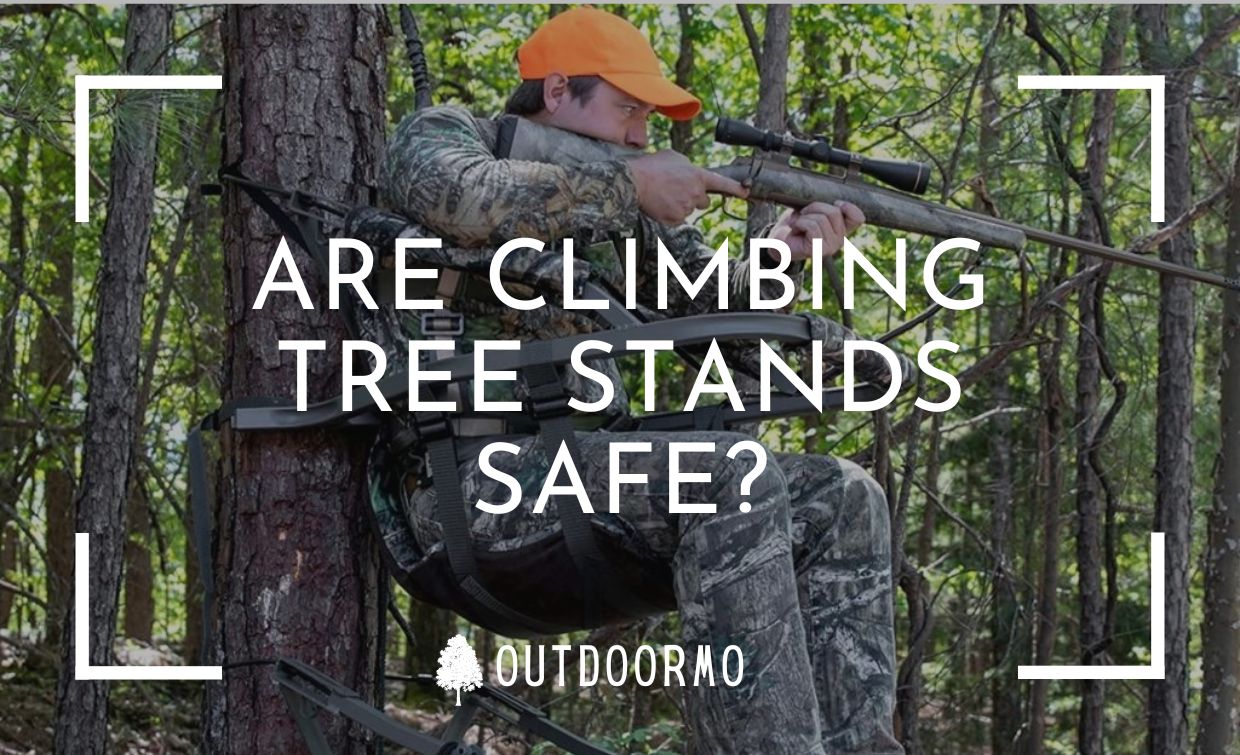Are climbing tree stands safe? As a responsible hunter deciding whether a climbing tree stand is right for you, it’s important to be aware of the associated risks, they can be dangerous if not used properly.
A climbing tree stand can be a great addition to your safety gear, they are a great way to get up high in the trees and increase your chances of spotting game, however, they can also be dangerous. Each year, between 3,000 and 4,000 people in the U.S. are injured after falling out of a tree stand. To avoid becoming a statistic, it’s important to take some basic tree stand safety
In this post, we’ll outline the risks as well as give you some tips for using a tree stand safely to help you decide is a tree stand is right for you.
Are climbing tree stands safe?
Yes, climbing tree stands are safe, but only when they are used properly. You must use it correctly, own the right tree stand safety equipment, and learn to pick the right type of stand for your needs and the right tree to attach it to.
What is the biggest hazard of tree stands?
As you’d probably expect, the biggest hazard of tree stands is the risk of falling. Falls can lead to significant injuries like broken bones, concussions, or in the worst cases, a head injury or spine damage that results in paralysis or death. This can happen for several reasons, such as the stand not being sturdy or properly installed. Hunters sometimes unintentionally make poor judgments or behave in a risky manner because they are in a rush or maybe under the influence of alcohol or other substances.
But when are you most at risk? Well, according to Bow Hunter Ed, a study of Vermont and North Carolina bowhunters revealed the following:
- 74% of the accidents occurred when climbing up or down or when installing or removing a stand.
- 73% said poor judgment and carelessness caused their fall.
- 21% of the accidents were related to structural failure.
Worryingly, 58% of the hunters who fell were not wearing a fall-arrest system and 80% still say safety was a concern but actually believed that a fall “wouldn’t happen to me.”
And what is also quite interesting is that 39% of the accidents occurred at less than 10 feet. So you don;t even need to be going that high to be at risk.
However, the good news is almost all of this can be avoided by avoiding poor judgment and risk-taking behaviors and above all, investing in (and using) a five-point harness. Always use safety harness than a rope during your hunt.
Different types of tree stand
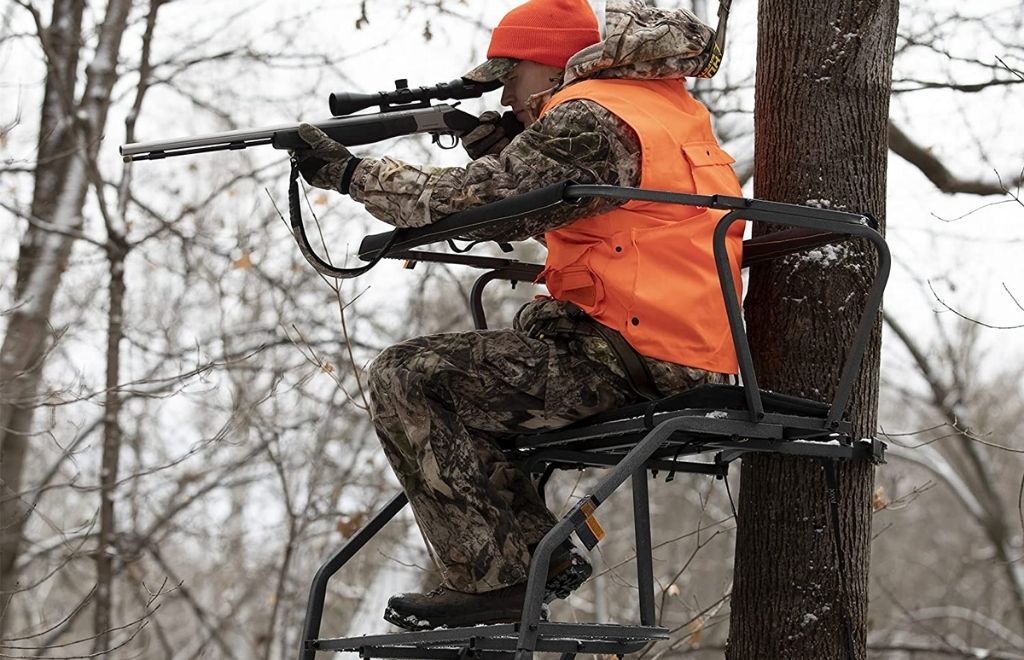
Treestands are an excellent addition to a collection hunting equipment, especially for deer season. They provide both visibility and stability. You will usually find three different types of stands.
Climbing tree stand
Climbing stands typically consist of two pieces – a seat cushion assembly and a platform assembly – which can be attached to the bottom of the tree. To use a climbing stand, the hunter must first attach both pieces to the tree and then start climbing by unlocking one of the pieces and moving it higher up the tree. This process is then repeated with the other piece until the desired height is reached.
The hang-on style tree stand
Hang-on stands are one of the most popular types of tree stands on the market, thanks to their affordability and portability. As the name suggests, a hang on stand attaches to the tree using chains or straps, and features a built-in platform and seat.
They are typically lighter than climbing stands (ranging from 10 to 35 pounds), and can be set up relatively quickly and quietly. The main downside of hang-on stands is that they require a bit of work to install, and can be tricky to get in and out of if you’re not careful.
Ladder-style stand
These stands usually consist of a multi-piece ladder assembly with a seat and platform at the top, which is secured to the tree by belts or straps. You can use them on any sturdy tree, and they don’t require screw-in steps. Deluxe ladder stands often offer padded benches and room for two hunters but are heavier and less portable.
When choosing a treestand, it is important to consider both your needs and your safety, and fortunately, there are many different models like Summit treestand viper, titan or goliath available to suit every hunter.
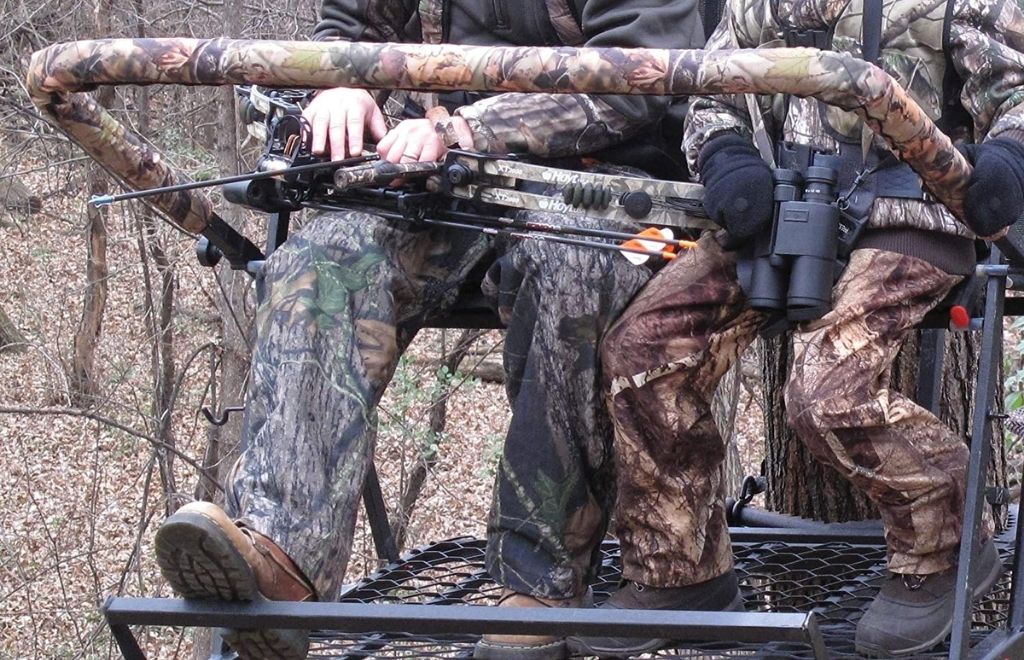
How to use a tree stand safely
Here are some helpful tips for using a tree stand safely:
Pick the correct stand
You first have to determine the specific characteristics of the stand and match them to two factors. These include your personal needs and where you plan to use the stand.
Check for a few specifications, such as the size, ease of use, and the unit’s weight capacity. If you are a larger hunter, then you may want to look at tree stands designed for big guys.
So , for example,
- If you hunt in areas with rough terrains consider a moderately sized tree stand models for easier portability.
- If you like to try various locations while hunting, consider the ease of putting up and removing the stand and how much noise you will make.
- If you value comfort over everything else, then look to the larger ladder-style.
These are just a few things to consider, try to think about your hunting style and chose a stand to match it.
Pick the correct tree
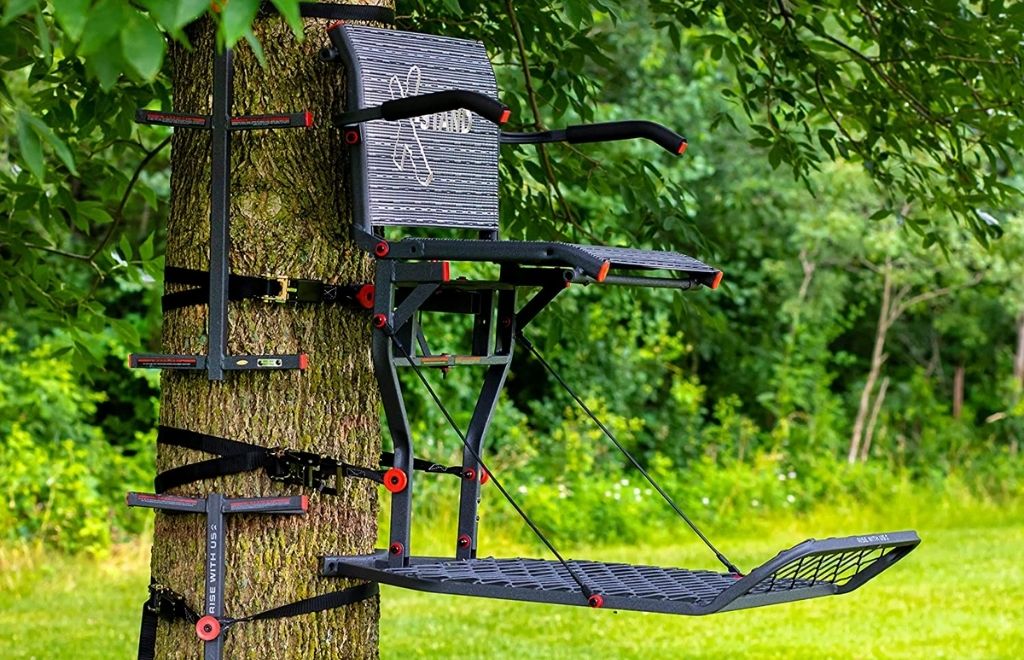
Once you find the ideal stand, consider the tree types in your preferred terrain. Do some reconnaissance in the woods first before buying a new treestand.
While this seems odd, the tree type determines your user experience, especially in your ability to get off the ground. One key aspect to consider is the width of the stand and the amount of weight it can carry upward.
For instance, a tree that reduces in width as you go upward is likely difficult to climb. You will also find it easy to climb on a straight tree. It might also compromise your ability to get a good height for viewing deer as you hunt.
So, ensure you check the tree’s characteristics first. Look at the trees from different angles, and determine if there are obstacles like small branches that require trimming.
Get the tree stand angle right
Achieving the perfect treestand angle is almost impossible, but this doesn’t mean you should not try. It is, in fact, an important treestand safety measure.
Ensure the stand requires the smallest amount of verticality, so it sits level when you get to the ideal hunting height. The tree diameter shares a directly proportional relationship with the starting angle. Do this to compensate for issues like platform drop.
You will also likely come across small trees that still provide an excellent hunting spot. So, how do you know if it’s safe to climb? The tree shouldn’t be so small so that it stops the tree stand safety harness from biting into the tree.
One of the best ways to solve this issue is to ensure the platform has sufficient verticality in the diameter differences that might arise. You will also learn to calibrate the positioning of your stand further over time.
Climbing trees
Now that you have gotten the tree angle correct, move on to ascend the tree and attach your stand, and here are the steps.
Please remember these are a general guide to help you decide if a stand is right for you; when you buy one, it will come with specific instructions for that model. It is imperative you follow the manufactures guide to be safe.
- Start this process by determining the farthest you will climb and wearing your helmet. If you have a bow and arrow, strap them to your body to avoid compromising the harness’s functions. Remember, you don’t have to climb to the very top of the tree to determine the best vantage point. Also ensure to avoid using smooth bark trees as tree climbers
- Attach the tree strap and two pieces to your preferred tree. In some cases, the tree stand might require additional weight to impart pressure on the tree-biting mechanism. Doing this helps prevent you from falling or having accidents as you climb.
- Then, attach the safety harness to your strap, and this should be ready to use. Proceed to loosen the tree strap and place it over your head.
- Then, tighten it once again. Set your feet in the stirrups of the bottom platform of the stand, and then move your torso through the top piece.
- Doing so will make it easy to use the sit-and-stand approach of tree climbing. Sit on the top stand section, and use your feet to drag the bottom portion upwards.
- Ensure the teeth of the safety harness bite securely in the bark, so it offers sufficient stability for your body weight.
- Repeat this process as you climb upwards. Remember to raise the tree strap, the bottom, and the top portion.
- Successful hunters will maintain this order religiously – because it’s one of the keys to climbing tree stand safety. Once you reach your desired height level, secure both climbing stand pieces to the tree. If you have friends or family who will tag along, ensure they also understand this safety perspective.
- Then, set the strap high, leaving a small slack between the safety harness and the strap. Doing this ensures the strap holds your body should you experience tree stand falls or a slip.
Getting back down
Once you are through using the climbing treestand, use the steps we recommended earlier for descending. Remember to double check each component as you get back down.
- You start by loosening the harness attached to your tree strap and lowering it.
- Next, sit on the top piece, and shift the lower piece downwards.
- Next, determine if the harness is safely into the tree’s bark and sit on it. Do this until you make your way down the tree. One of the key safety tips for you is to ensure you maintain all the same steps we have mentioned above.
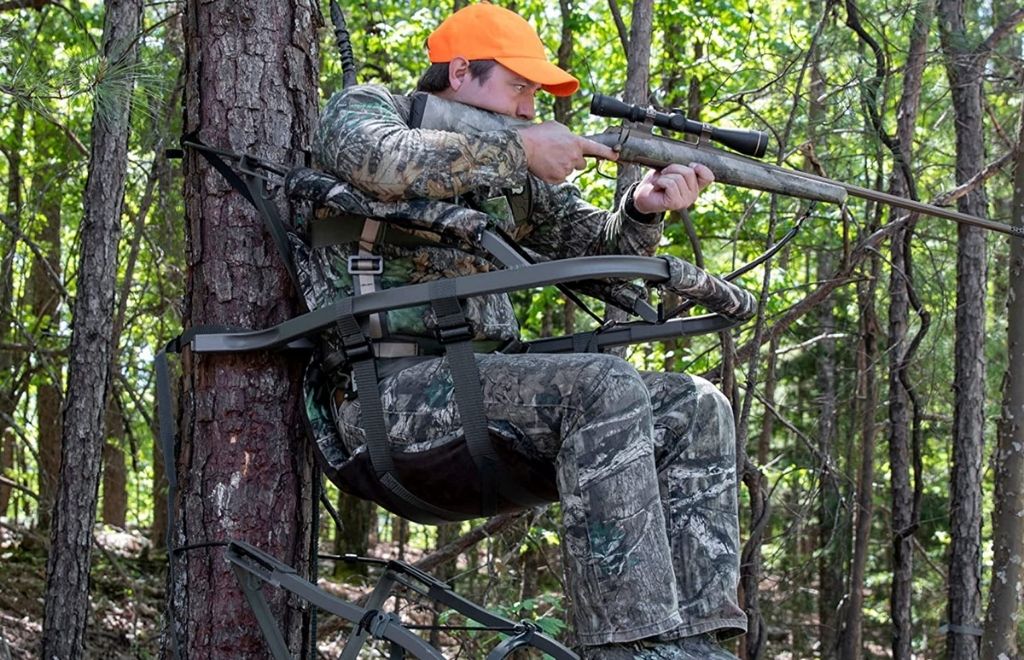
FAQs
Can you leave a climbing tree stand up all year?
You should avoid leaving climbing tree stand up all year as it won’t remain safe. The tree can grow bigger, and this can cause damage to the harness components. Any compromise of the stand components increases the risk of serious injury or falls. Even leaving it up the tree all through hunting season is bad. All climbers are responsible for maintaining the stand’s position properly, so are aware of its stability. Hunters can try practice hunting off season but should also be careful not to leave the tree stand after hunt practice
How high should you go in a climber tree stand?
You can go with your climber tree stand as far as you want as long as you maintain optimal safety. Usually, most deer hunters use the 20 feet tree height maximum as the benchmark. That is because it provides a great line of sight and isn’t too high to cause accidents.
Do climbing tree stand damage trees?
Climbing tree stands don’t damage trees, especially when you use them correctly. While the harness might bite into the bark, and you must cut some leaves, it won’t cause any major tree damage. Plus, they are most helpful during hunting season. So, there is plenty of time for the tree foliage to grow.
Final thoughts
Tree stands in themselves are not dangerous, however, when used irresponsibly, they become a risk. If you do decide to invest in one, be sure to follow all the safety advice and instructions given by the maker and, of course, wear the right safety harnesses, your life depends on it.

